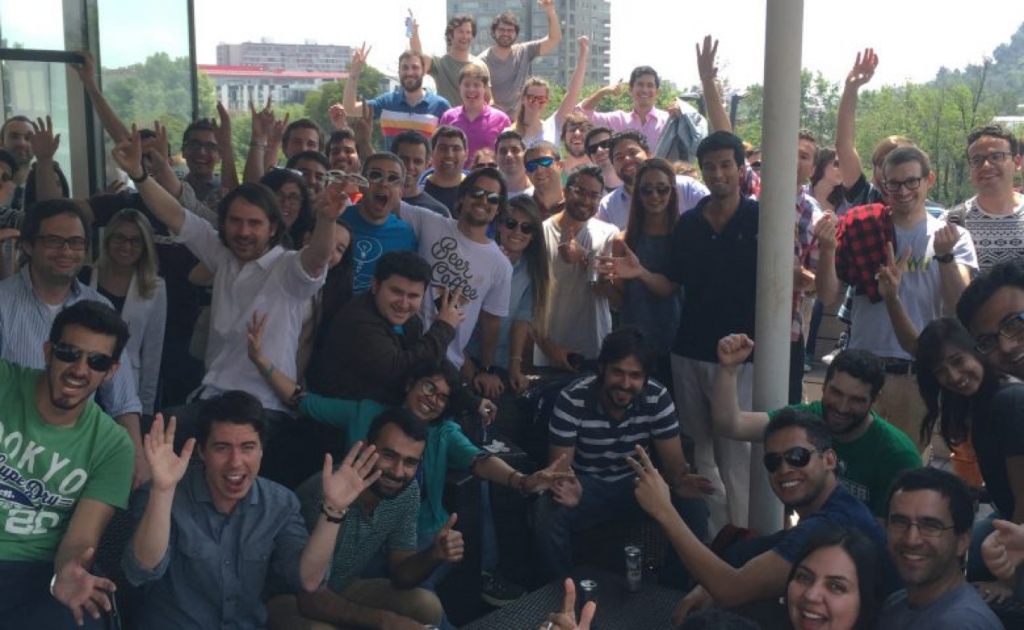Last week after a speaking engagement in Vina del Mar, Chile, I stayed an extra day to check out all things innovative. Sure glad I did. Learned a lot. Accompanied by Lydia Bendersky, of HiCue Speakers Bureau, we visited innovative companies and innovation centers. Here is my report:

Part of the Dream Team that Produced the Mining Industry’s First Robot.
In 2010, a Chilean mining accident trapped 33 miners 2,300 feet underground for 69 days, and suddenly increasing mine safety became a pressing priority. For Chilean mining company Enaex Group, who’s parent company is Sigdo Koppers, the accident was a catalyst to use technology to increase safety by moving humans out of harm’s way. Last week a team of innovators, under the direction of Enaex project manager Marco Ruiz Hernandez, unveiled RoboMiner, a remotely operated robot that can monitor temperatures, measure topography, place explosives and record what it sees using 3D vision. Technologies like RoboMiner and Enaex’s recently introduced driverless trucks, both developed in cooperation with Stanford Research Institute, ASI Robots, Thecne and SK Godelius, point to the increased pace of innovation in Chile’s top companies. “These projects were specifically created to continue enhancing the mining operation and its resources, but also taking care of our greatest value: the lives of miners,” said Juan Andres Errazuriz, Enaex’s award winning CEO, who championed the project throughout.

The Chilean Wine Industry is Growing by Leaps and Bounds.
The road from Santiago, Chile to the coastal towns of Valparaiso and Vina del Mar pass through the fertile Casablanca Valley, one of Chile’s largest wine growing regions. Thirty years ago, a dozen wineries produced product and but barely any of it was exported. Today, there are over 339 wineries, and the country’s wines show up on dinner tables around the world. In addition, the country’s agriculture sector, fishing and tourism are also bright spots.

Startup Chile Facilitates Entrepreneurship and Inspires Big Ideas.
“Ten years ago my graduating class all wanted to be CEOs of big companies,” Manuel Cartes, director of Business Innovation for CORFO Chilean Economic Development Agency, “today they want to be entrepreneurs. They want to do stuff. They are thinking big.” One hundred fifty fledgling businesses are currently being funded by CORFO, and among the success stories are Crystal Lagoons, which has developed and patented a state-of-the-art technology that enables crystal clear lagoons of unlimited sizes to be built and maintained at very low costs.

What’s a Country Without an Innovation Center?
In 2014, with funding from the wealthy Angelini family, Chile’s Catholic University built the country’s first innovation center. Set within Universidad Católica’s large San Joaquín Campus, the massive, cubist concrete building features warm woods and numerous collaboration nooks and workspaces, along with maker labs and ample room for startups to incubate. Furthermore, the center was commissioned to and designed by the 2016 Pritzker Prize architect Alejandro Aravena.

Center of Innovation Helps Country Embrace Change.
“Having a tech transfer office is new here in Chile,” says Conrad von Igel, director of the Center of Innovation, which seeks to promote innovation within the university and to help the country embrace change. The center does contract research, technology transfer, hosts a 110 company consortium, and houses startups in its midst. Leading firms like Arauco, a timber and paper products company, and three others have set up labs in the building to do applied research, and network for talent. “We’re bringing global megatrends to Chilean businesses, from an awareness of millennials and demographic changes, to the application of big data to business issues,” notes center director Igel, seen here with colleagues.

You Can’t Build an Innovation Culture Overnight, But the Best Time to Start is Right Now.
That’s what I told 80 or so senior executives of one of Chile’s top industrial conglomerates, which gathered representatives from Europe, North America and South America at Vina del Mar, Chile. According to one survey, only 16 percent of Chilean companies say they do innovation in any concerted way. But the triple challenges of slowing growth, a lack of differentiation of products and services, and the threat of digital disruption has alerted more and more companies to the need to embrace change and build a culture of innovation. While lists of “most innovative companies in the world” often use patents or research spending to measure innovativeness, my work over the years has revealed five best practice categories that distinguish companies which outpace their rate of growth over industry peers, and sustain their success over time. They embrace the opportunity mindset. They implement superior idea management systems such that no good idea goes untested. They collaborate with their customers and strategic partners. They cultivate risk-taking cultures. And they involve everybody in the enterprise.
